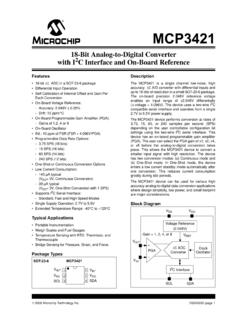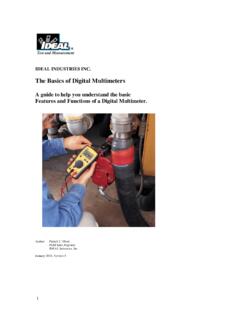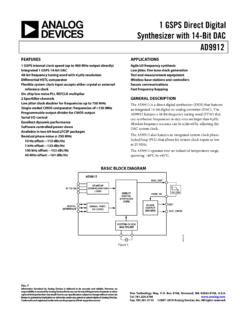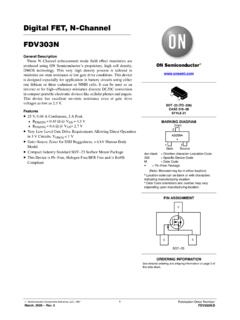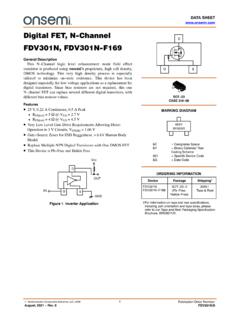Transcription of Experiment 8: Capacitance and the Oscilloscope
1 INTRO TO EXPERIMENTAL PHYS-LAB 1493/1494/2699 Experiment 8: Capacitance and the Oscilloscope Nate Saffold Office Hour: Mondays, 5:30PM-6:30PM @ Pupin 1216 PHYS 1493/1494/2699: Exp. 8 Capacitance and the oscilloscope2 Outline Capacitance : Capacitor as a charge storage device Capacitors in combination RC circuits: exponential growth and decay Oscilloscope : Conversion of analog signals to digital Display and signal operations Measurements: Large RC charging Large RC discharging Small RC cycle observed with the oscilloscope3 Main components of a circuit Even though the behavior of every element of a circuit can be explained on a microscopic electromagnetic basis, it is convenient to introduce a schematic representation of them All the microscopic features are embedded in few macroscopic quantities (current, resistance, Capacitance .)
2 Most common components are: : it provides a constant potential difference through the circuit. Its macroscopic quantity is the ( ) : it causes a drop in the voltage due to microscopic collisions between the flowing charges and the atoms of the material or interactions with EM potential. Its macroscopic quantity is the resistance ( R ) : it is composed by two conductors ( plates) separated by a non-conducting material. When a battery pumps charges on the plates a potential difference between them is created. Its macroscopic quantity is the Capacitance ( C )PHYS 1493/1494/2699: Exp. 8 Capacitance and the oscilloscope4 Kirchhoff laws The fundamental laws of circuits are the so-called Kirchhoff s laws 1st law: When considering a closed loop inside a circuit, the total potential difference must be zero 2nd law: When considering a junction, the sum of the ingoing currents is equal to the sum of the outgoing onesPHYS 1493/1494/2699: Exp.
3 8 Capacitance and the oscilloscope5A simple circuit Battery supplies potential difference Current flows from high potential to low The voltage drop across a resistor is given by Ohm's Law:For a series of resistors:PHYS 1493/1494/2699: Exp. 8 Capacitance and the oscilloscope6 Capacitors A capacitor is a device that stores electric charge, and therefore energy. Examples: camera flashes, computer chips, defibrillators, Example: two conducting plates, separated by a gap, with voltage V across them. The total charge Q that can be stored on the plates is proportional to the potential generated, V. Constant of proportionality: a geometry-dependent quantity called of Capacitance are Farads (F):1F = 1C/1 VPHYS 1493/1494/2699: Exp. 8 Capacitance and the oscilloscope7 Combination of capacitors Capacitors in series:Capacitors in parallel:PHYS 1493/1494/2699: Exp.
4 8 Capacitance and the oscilloscope8 Combination of capacitors Capacitors in series:Capacitors in parallel:Voltages addCharges are the samePHYS 1493/1494/2699: Exp. 8 Capacitance and the oscilloscope9 Combination of capacitors Capacitors in series:Capacitors in parallel:Voltages addCharges are the sameVoltages are the sameCharges addPHYS 1493/1494/2699: Exp. 8 Capacitance and the oscilloscope10 Resistor-capacitor (RC) combinations When resistors and capacitors are used together in circuits, interesting things start to happen. A resistor will draw current from a battery; a capacitor will store the current's flowing charge. Recall: voltage expression for a resistor is given by Ohm's Law: , where Voltage expression for capacitor: . Put these two together (a series RC circuit), and you get exponentially decreasing current flow PHYS 1493/1494/2699: Exp.
5 8 Capacitance and the oscilloscope11 Charging a capacitor with a battery Put a capacitor in series with a battery. Capacitor is initially uncharged. Close the switch. By Kirchoff s 1st law:Provides potential differencePositive charges of current lose energy when getting close to positive charges on plateResistors always cause a loss of potentialPHYS 1493/1494/2699: Exp. 8 Capacitance and the oscilloscope12 Charging a capacitor with a batteryPHYS 1493/1494/2699: Exp. 8 Capacitance and the oscilloscope13 Charging a capacitor with a battery Need dQ/dt proportional to Q exponential function Note the extra constant, so lets try:PHYS 1493/1494/2699: Exp. 8 Capacitance and the oscilloscope14 Charging a capacitor with a battery Need dQ/dt proportional to Q exponential function Note the extra constant, so lets try:Substitute into differential equation: Compare left and right sides to determine A and :PHYS 1493/1494/2699: Exp.
6 8 Capacitance and the oscilloscope15R qSCharging a capacitor with a battery So, as we derived, the charge stored on the capacitor as a function of time is: The current flowing through the circuit is instead:Fully charged Current decreases exponentially because capacitor is fully charged The constant is the typical time scale for charging/discharging the systemPHYS 1493/1494/2699: Exp. 8 Capacitance and the oscilloscope16 Discharging a charged capacitor Put a charged capacitor in series with a resistor. Close switch; charge will dissipate through the resistor. Again, by Kirchhoff's loop ruleThe calculation is now very similar to the case we just 1493/1494/2699: Exp. 8 Capacitance and the oscilloscope17 Discharging a charged capacitor In this case, the current I(t) decreases exponentially, just like the previous charging case.
7 However, in this case, is because the system is running out of charges Sign of current is negative, indicating that flow is in the opposite directionPHYS 1493/1494/2699: Exp. 8 Capacitance and the oscilloscope18A better plot for current On a standard plot of I vs. t, I(t) approaches zero exponentially. This is hard to visualize or quantify Better solution: plot log(I) vs. t. In this semi-log plot the current will look like a straight linePHYS 1493/1494/2699: Exp. 8 Capacitance and the oscilloscopeHorrible of the exponential function Why does the exponential function look like a straight line on a semi-log plot? Taking the (natural) logarithm converts the exponential function to a linear function in time t. PHYS 1493/1494/2699: Exp. 8 Capacitance and the oscilloscope20 The ExperimentPHYS 1493/1494/2699: Exp.
8 8 Capacitance and the oscilloscope21 Goals In this Experiment you will study different RC circuits and observe their properties Main goals are: Use a timer to measure RC from the charge and discharge curve of a circuit with larger RC (slow) Familiarize with an Oscilloscope Use the Oscilloscope to study a circuit with small RC (fast)PHYS 1493/1494/2699: Exp. 8 Capacitance and the oscilloscope22 Measurement of large = RC In the first part of the lab, you will observe the time dependence of the current in two circuits with large RC values ( long charge/discharge typical time). Idea: charge the capacitor bank (C = 10 F, 2 0 F, 3 0 F). Pass the current through the ammeter so we can measure it. Ammeter has large unknown internal resistance R that determines the time constant = RC.
9 RC circuit of interestThis is only used to dischargePHYS 1493/1494/2699: Exp. 8 Capacitance and the oscilloscope23 Large charge setupPower SupplyTimerOldest switch in the worldDischarge resistorAmmeterOldest capacitor in the worldBack in my days, this was high 1493/1494/2699: Exp. 8 Capacitance and the oscilloscope24 How to use the oldest switch in the worldABCDEFC losing the switch on the left connects A with B and D with EClosing the switch on the right connects B with C and E with FPHYS 1493/1494/2699: Exp. 8 Capacitance and the oscilloscope25 Measurement of large = RC For three settings of the capacitor bank C = 10 F, 2 0 F, 3 0 F, observe I(t). There is a timer you can use to read off 1s intervals Calculate ln(I(t)) and perform a linear fit of the logarithm vs.
10 Time. Get three values for the time constant , then get three values for internal resistance R. Calculate mean R and the standard error on the mean. Compare your results obtained with your plot of log current vs. time might look likePHYS 1493/1494/2699: Exp. 8 Capacitance and the oscilloscopeWatch out! Horrible The Oscilloscope allows us to visualize signals that vary rapidly with time. Very handy! Idea: scope converts voltage waveforms from analog to digital , then displays the signal on an LCD screen. What you need to do: Learn how to display voltage signals from function generator on the scope. Learn how to use the scope's measurement digital Oscilloscope samples input voltage signal at regular intervals using an analog-to- digital converter (ADC)PHYS 1493/1494/2699: Exp.














